Learn how to easily vacuum seal Mason jars! Vacuum sealing jars of fresh or dried food will protect and keep your food fresher for longer!
This morning, I shared a quick tip on Instagram about one of my favorite ways to preserve zucchini:
That’s right: you can use your FoodSaver to vacuum seal Mason jars! Pretty awesome, right?
After posting the picture on Instagram, I started getting questions about how I vacuum seal the mason jars and what equipment I use. I shared an Instastory with all the details, showing the entire process. If you want to check it out, you can find it in my story highlights on my Instagram profile. But I thought I should also write a post about it to share the step-by-step process with those of you who don’t have Instagram. (But really, you should get Instagram and follow me because I post pictures of cute goats. What better reason could you need?!)
All About Vacuum Sealing:
Vacuum sealing is a fantastic food preservation hack! Vacuum sealing is a process that uses suction to remove air from a package before sealing it. When air comes in contact with food, it starts to break it down slowly. Exposure to air and moisture encourages bacterial and fungal growth – definitely not something you want on your food! By removing excess air, your food will be able to stay fresher for longer.
Vacuum sealing is ideal for food that you intend to store for long periods of time, but you can also vacuum seal fresh food to help them last longer. However, vacuum sealing IS NOT a substitution for pressure canning or water bath canning. If you are vacuum sealing fresh or wet foods (meat, sauces, jams, etc.) they will NOT be shelf-stable. You will need to store them in a fridge or freezer. However, vacuum sealing is still a very valuable tool for your frozen and fresh foods! Vacuum sealing will help your foods last much longer and avoid freezer burn.
In addition to vacuum sealing fresh and frozen foods, this is also an ideal way to store foods that have been dried or dehydrated, like the zucchini slices I posted about! If foods are properly dried and vacuum sealed, they will be shelf-stable and can last for years!
Supplies for Vacuum Sealing Mason Jars:
If you are ready to start vacuum sealing jars of delicious homegrown foods, you will need to gather some supplies.These tools are ones that will become a valuable addition to your food preservation supplies and are well worth the money!
There are many brands of vacuum sealing machines, but I chose to go with the FoodSaver brand. It’s a brand that has been around for many years. I also liked that they are generally easy to find parts, pieces and accessories for since it is a common brand. You can also commonly find and purchase used machines that are in very good condition, which will help save some money. I purchased my FoodSaver machine used from Facebook Marketplace. It’s an older model, but it was only used once, is in great condition, and cost a fraction of what new machines cost! I purchased the accessory items from Amazon, and I’ve included links below to all the supplies!
**This post contains affiliate links for awesome products. We may receive a commission at no expense to you if you choose to purchase items using these links. See our full affiliate disclosure here. Thanks for helping support this blog! **
Supplies:
- A vacuum sealing machine (I have the FoodSaver V2222)
- Jar sealer (These come in both wide mouth and regular mouth. I linked them below individually or as a bundle with the cord)
- Accessory cord to connect the jar sealer to your machine
- Mason jars
- Oxygen absorber packs (optional)
How to Vacuum Seal Mason Jars:
- Begin with a clean and sterilized jar (you can sanitize your jars by boiling them in a big pot of water for 10 minutes. Be sure to fully dry them before you add dried foods!). Pack your jar with your food items. Leave about half an inch of headspace. If you are planning to freeze your jar, leave at least 1-inch of headspace.
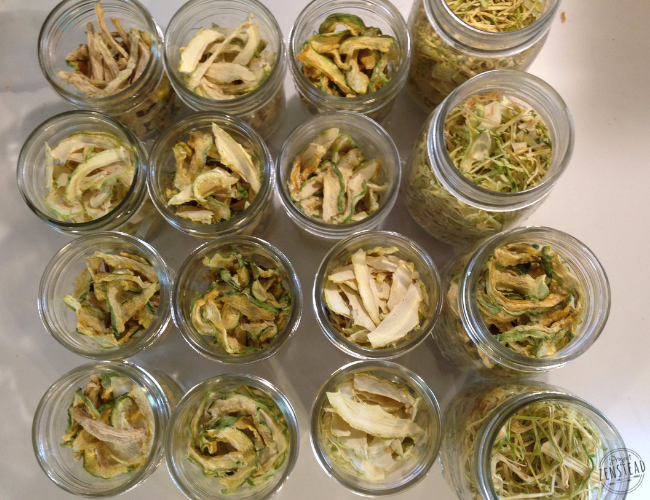
- Optional: If you are sealing dried foods, you can add an oxygen absorber pack to your jar. This is not necessary, but will help absorb any extra oxygen that may be left after the sealing process. It will also help absorb any moisture if your seal breaks at some point.
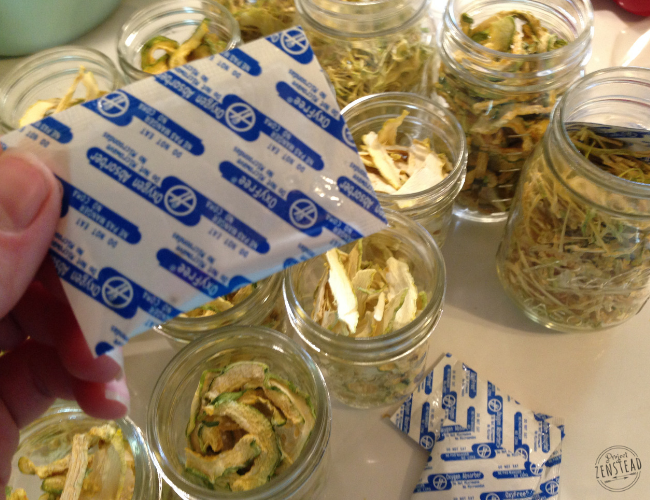
- Wipe the rim of your Mason jar clean, if needed
- Place the jar lid on your Mason jar and make sure it is centered and sitting properly on the jar rim.
- Place the jar sealer over the Mason jar. It will gently “snap” into place and should fit over the jar securely.
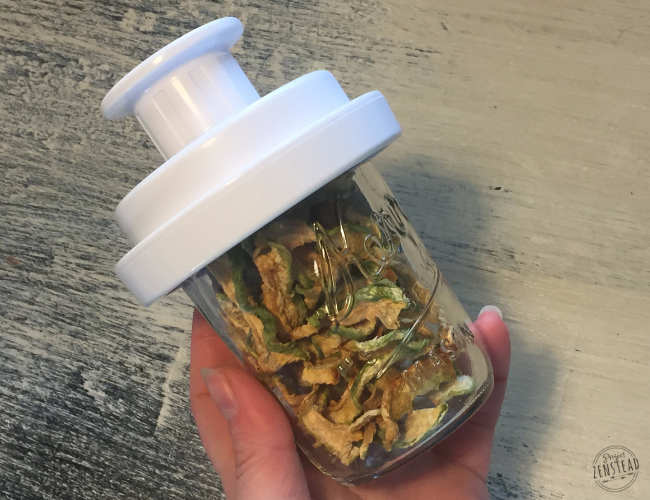
- Plug the accessory cord into the accessory port on your vacuum sealing machine. Plug the other end into the port on the jar sealer.

- Lock your vacuum sealing machine.
- Press the “Vac/Seal” button on your machine. Your machine will turn on and will begin suction.
- Wait until your machine stops applying suction and the lights above the buttons turn off. You can then unlock the machine and remove the lid sealer from your jar by gently pulling straight up.

- The jar lid should be sealed and you can test the seal by holding the jar by the rim of the lid and making sure that the “button” on the lid is fully depressed. I place the ring back on my vacuum sealed jars, just in case the seal breaks at some point in the future.
- Don’t forget to date and label your jar!
Troubleshooting:
Every once in a while, you will find that a jar lid doesn’t seal or that it pops off when you try to remove the jar sealer. This seems to be more common with the regular mouth than with the wide mouth for some reason. Some things that I’ve found that help with this include:
- Make sure that your jar lid is centered on your jar before placing the jar sealer on it.
- When you place the jar sealer on your jar, press down directly in one fluid motion and don’t wiggle it once it is on. Wiggling the jar sealer once it’s on the jar seems to loosen or displace the lid just enough to disrupt the seal.
- When you remove the jar sealer from your jar, slowly but firmly pull straight up. Again, wiggling seems to pull the lid off with the jar sealer sometimes.
- When all else fails, just try again! I usually get it sealed perfectly on the second try!
What kinds of delicious foods will you store using the Mason jar vacuum sealer? Share in the comments below!
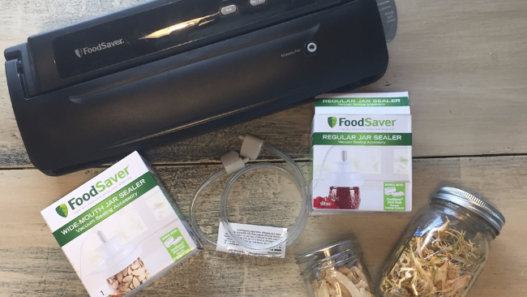

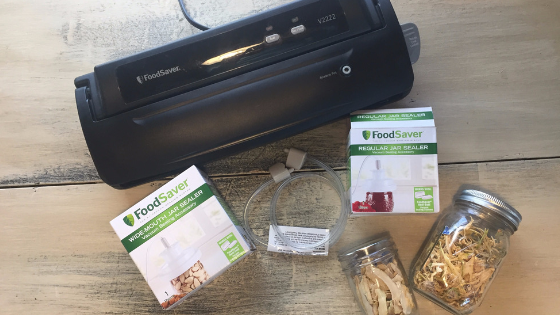
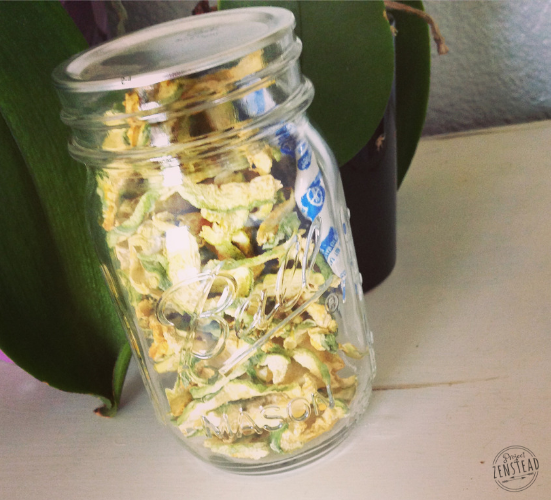
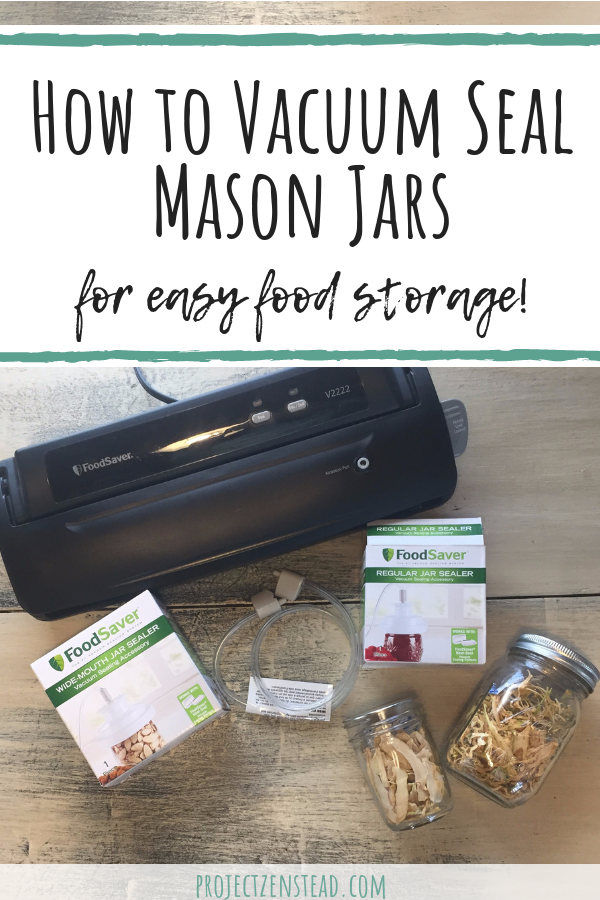



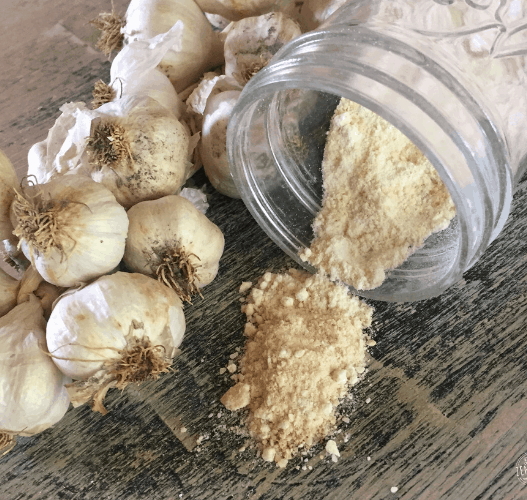
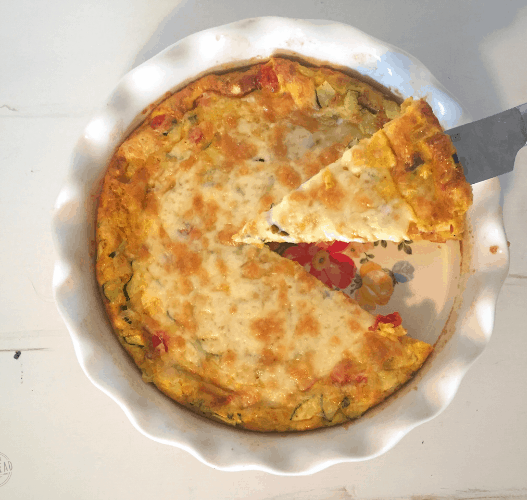
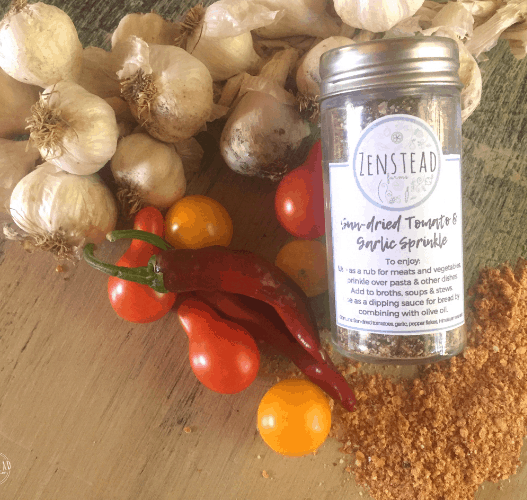

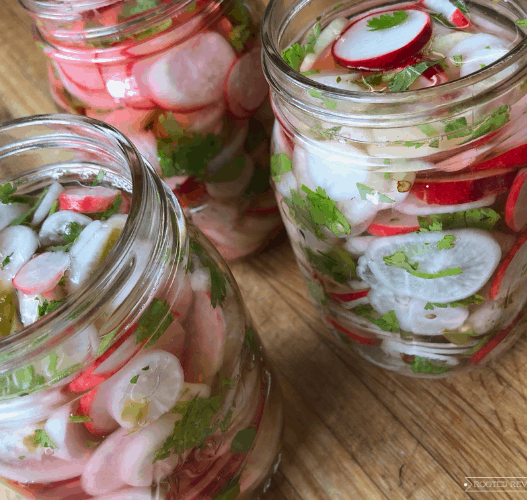
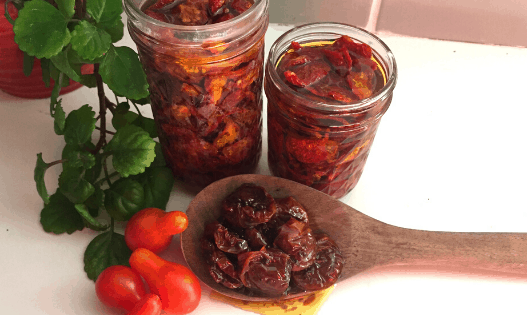
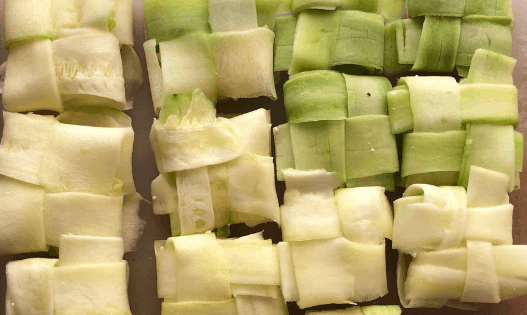
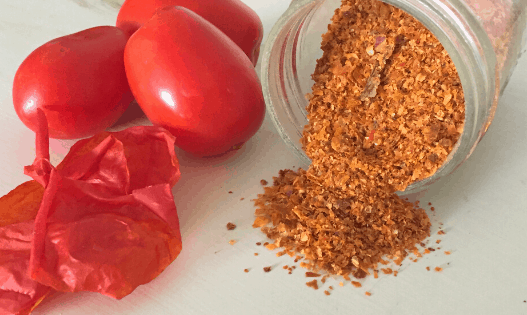
I didn’t know you could do that with a Foodsaver! I’m just getting into canning and food storage so this is great for a beginner
Dehydrating is a great way to start preserving your own food! Glad this helped!
I had no idea you could vacuum seal mason jars!! Very cool. I love dehydrating things, but storing them has always presented a challenge due to moisture. Now I know what to do. Thank you !
I’m so glad! I hope the process works well for you and you enjoy it as much as I do! 🙂
What a great way to fill jars once they’re empty before canning season begins! It would force me to rotate my dehydrated AND canned stuff. Hmm…thinking I might need a vacuum sealer again.
That’s exactly what we do! 🙂 It works very well!
This is a great idea and option for my dried fruits and vegetables. You don’t mention if the lids need to be new and not previously used. I assume that if the lid is in relatively good condition it would still seal when pulling the air out of the jar and then also replacing the ring tightly?
What are your thoughts on that?
Great point! Yes, I use ones that are used but still in good condition. If I have one that really doesn’t want to seal, I will switch it out and grab a different, but I haven’t had that happen too often. Hope this helps! 🙂
Do you sterilize lids and bands prior to vaccine sealing. Thanks bp
Hi Beverly! I don’t do a full sterilization (10 minutes in boiling water) but I do run them through a hot cycle in the dishwasher prior to using them.
Why can’t you vacuum seal wet or fresh foods in mason jars? I’m looking for a non-plastic way to store my prepped meals in the freezer.
You definitely could vacuum seal fresh foods and then keep them in the fridge or freezer. Dry foods are the only ones that would shelf-stable through. 😀
Can anyone recommend a place to purchase mason jars in bulk at reasonable prices for for storage?
Can anyone recommend a place to purchase mason jars in bulk at reasonable prices for storage?
I wish I did! Unfortunately, it’s been incredibly hard to find jars and lids since 2020. I know that U-Line sells glass jars, but I have not personally used them. I would caution you to be wary of anything on Amazon at this point as I’ve hear there are many many fakes that are repackaging cheap Chinese made jars and labeling them as Mason jars. Best of luck in your search. Let us know if you find a good source!
@Gina Kamak,
If you have a Goodwill or thrift shop near you, check there. We recently picked up about 300 mason jars of different sizes on a certain savings day that we could benefit the most. We have a Goodwill member card (no fee) that you can qualify for senior, military, birthday discounts along with the weekly certain color tags and a discount day on the 15th of the month. We chose to shop on a Tuesday (military day -10% off), the 15th (25% off on purchases of minimum $25.00, and my husband’s birth month (25% discount one day only in birth month). We also searched for that weeks tag color. We paid between .50 and .99 minus 10% and another 25% and another 25% off. We hit 7 stores that day. I think I am good on jars for a while. It was well worth it. Good luck.
@Rooted Revival, Walmart does sell Kerr jars. Off brand of mason jars
Is it necessary to store with rings on? Do they rust?
@Martha, It’s not necessary to store jars with rings on. In fact, it’s better to store them without the rings to prevent rust and ensure a proper seal. Rings can trap moisture, which can lead to rusting.